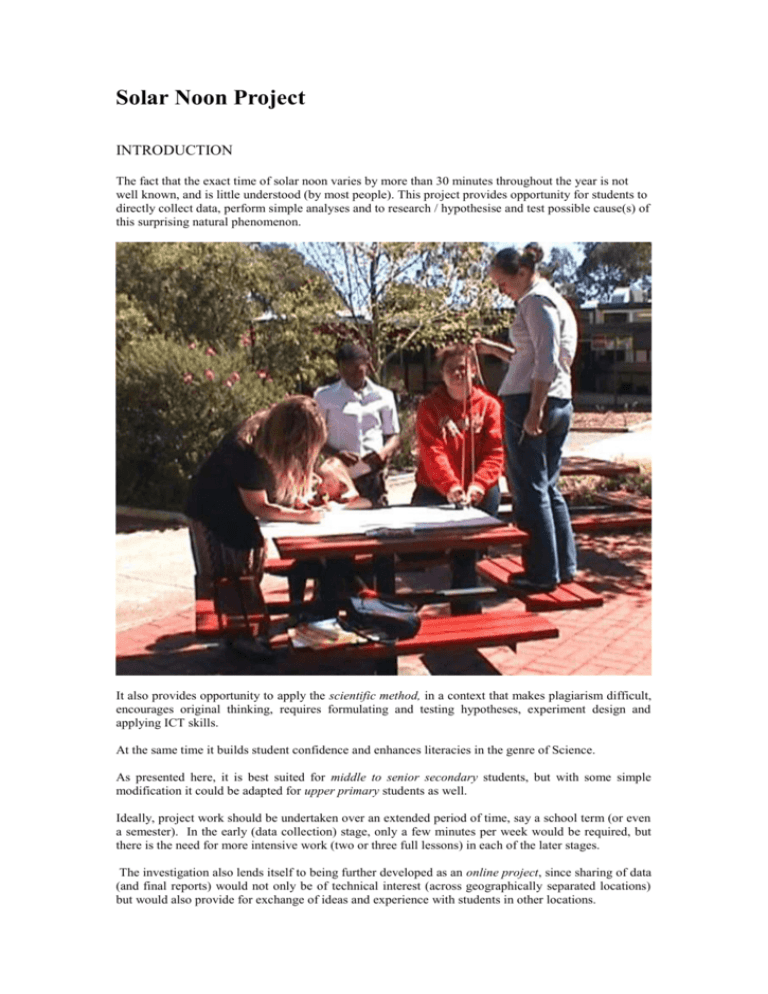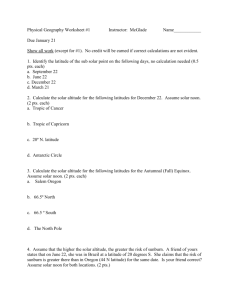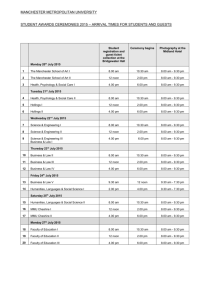Solar Noon Project
advertisement

Solar Noon Project INTRODUCTION The fact that the exact time of solar noon varies by more than 30 minutes throughout the year is not well known, and is little understood (by most people). This project provides opportunity for students to directly collect data, perform simple analyses and to research / hypothesise and test possible cause(s) of this surprising natural phenomenon. It also provides opportunity to apply the scientific method, in a context that makes plagiarism difficult, encourages original thinking, requires formulating and testing hypotheses, experiment design and applying ICT skills. At the same time it builds student confidence and enhances literacies in the genre of Science. As presented here, it is best suited for middle to senior secondary students, but with some simple modification it could be adapted for upper primary students as well. Ideally, project work should be undertaken over an extended period of time, say a school term (or even a semester). In the early (data collection) stage, only a few minutes per week would be required, but there is the need for more intensive work (two or three full lessons) in each of the later stages. The investigation also lends itself to being further developed as an online project, since sharing of data (and final reports) would not only be of technical interest (across geographically separated locations) but would also provide for exchange of ideas and experience with students in other locations. The Solar Noon Project PART 1 : What is Solar Noon ? Search the web to find and record a brief explanation of each of the following terms, using : http://www.google.com.au/ (a) (b) (c) (d) (e) (f) latitude longitude sunrise sunset time zone solar noon Save these explanations, and also record the source of each. They will be useful in compiling a glossary of terms, which will be a required part of your final report. PART 2 : Does Solar Noon vary ? A : According to published data Look in the “weather” section of your daily paper, for local sunrise and sunset times. Notice that these times are (usually) for the day following the date of the newspaper. Assuming that solar noon occurs exactly half way between sunrise and sunset, determine the exact mid point between these times, as shown in your newspaper. Record this “half way” time as predicted solar noon, together with the date. Repeat this process every 4-7 days, until you have a collection of data which extends over at least a period 8-12 weeks. Record these predicted times and dates either in a table format or (preferably) using an excel spreadsheet. Construct an appropriate graph (preferably using excel Chart Wizard), to demonstrate variation over time (if any) at your location. Use your graph to answer the following questions: (a) Has the time of “predicted” solar noon changed ? (b) Describe the change (if any). Save your graph and your description (preferably in a Word document), for use in your final report. B : According to direct measurement Refer to your explanation of “solar noon” in PART 1. You may notice (or have read) that it is the time (on any day) when the sun is at it’s highest point in the sky, in other words the time when the shadows of objects are at their shortest length, at a particular location. Your aim is now to test “predicted” times by direct measurement of shadows. Design a method of measuring, (as accurately as possible), the time of shortest shadow length. Your method should be in the form of clear and precise instructions that other students could follow Record and save a list of the steps involved in your method. Using your work in A as an approximate guide, use the method you have designed to measure the time of shortest shadow (solar noon), at your location, and repeat this measurement every 4-7 days over a period of at least several more weeks. Record and save this data for further use. C : According to online calculators There are numerous online calculators that can determine solar noon for any location, providing that you have the correct longitude and time zone for that location. For major cities, towns and suburbs within Australia, latitude and longitude can be looked up at: http://life.csu.edu.au/geo/findlatlong.html Record and save the latitude and longitude of your location, (from the above source), and also record the time zone in which your location lies. Now that you have this information, use the following website to calculate and print a “solar noon calendar” for the year 2004 for your location, by visiting: http://www.solar-noon.com/ D : According to Geoscience Australia Choose at least five dates for which you have data in A and B above, and for each of your chosen dates use the following website to determine a fourth estimate of solar noon, for each of those dates. http://www.ga.gov.au/ E : Comparing data from different sources Copy and paste the following table into your Word document, enter your chosen dates and complete the table using the data collected from each of the sources indicated. Solar Noon for ………………..…………………… (name of location) Date A from newspaper …………………… B by direct measure of shadows C from calendar D Geoscience Aust www.solar-noon.com www.ga.gov.au (name of paper) By referring to the above table, write a paragraph describing any differences in the data. Clearly state which source you regard as the most reliable, giving reasons for your answer. PART 3 : Looking for a pattern Use the calendar (printed in B above) to choose and highlight solar noon times at weekly intervals throughout the year. (You might choose each Monday, for example). Convert each of these times (from hrs./min./sec) to decimal equivalents in hours. (eg. 12: 18: 45 converts to 12.3125 hrs.) Open an excel spreadsheet and enter the weeks and (converted) times, as follows: Variation in Solar Noon for …………………… for 2004 WEEK TIME 1 12.3125 2 12.2875 3 12.2500 4 12.2356 etc. …….52 etc. ……. By referring to your chart estimate the period (eg. time between adjacent peaks) and the amplitude (ie. size) of any cyclic variation evident in this data. PART 4 : Searching for an explanation via webquest Cyclic variation implies a cyclic cause. In this case, it is reasonable to expect that variation in solar noon might be caused by changes in the orientation of the earth’s axis of rotation, in other words variation in the position of the geographic poles. One such motion of the earth’s axis is the Chandler Wobble. The effect of this “wobble” on the position of the North pole can be seen at: PART 5: Writing a Report Refer to the marking scheme provided. Write a well presented report, covering the points listed and demonstrating the work you have done throughout this project. RECOMMENDED FURTHER ACTIVITIES: THE NOONDAY PROJECT is an excellent biannual online project which uses the Eratosthenes method of calculating the circumference of the earth. Upper primary to Adult students share solar noon shadow length data (around the world), and collaborate in their calculations. http://www.ciese.org/




